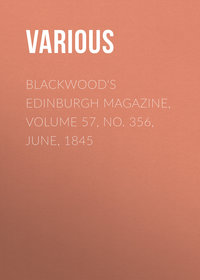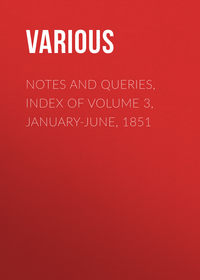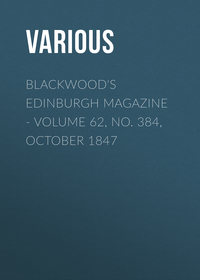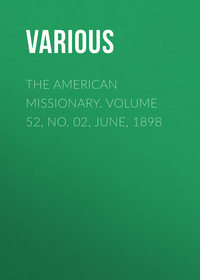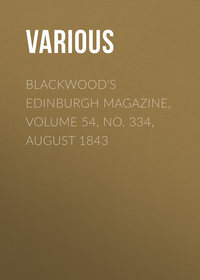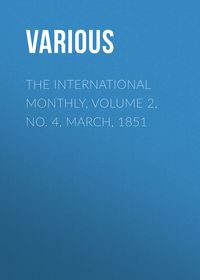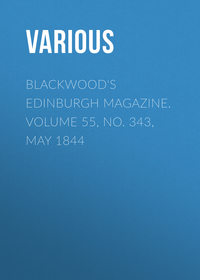 полная версия
полная версияThe Mirror of Literature, Amusement, and Instruction. Volume 20, No. 573, October 27, 1832

Various
The Mirror of Literature, Amusement, and Instruction / Volume 20, No. 573, October 27, 1832
OLD HALL, IN DERBYSHIRE

This picturesque specimen of olden architecture stands upon the Norton Lees estate, on the northern verge of Derbyshire upon the adjacent county of York; about a mile from Sheffield, and eight miles north of Chesterfield, and but a short distance from Bolsover Castle, pictured in No. 566 of The Mirror. "The estate, in the reign of Henry VII., was the property of the family of the Blythes of Norton, two of whom arrived at great honours in the church; one of them, John, being the Bishop of Salisbury, and the other, Geoffrey, Bishop of Lichfield and Coventry."1 The above was the mansion of the family: its picturesqueness is of pleasing character; and our inquiry into the probable age of the structure has naturally enough led us into a few observations upon the early domestic architecture of this country. The subject is, however, too rife with interesting details for the present occasion; so that all we now purpose is by way of reference to the specimen or illustration before us.
The house at Norton Lees has been supposed by some persons to be as old as the reign of Richard II.; but Mr. Rhodes observes, "that it was erected many years after this period can hardly be doubted." Certain features of resemblance assist its appearance of antiquity, as the wooden framework, which is observable in the oldest specimens of house-building in this country. According to Strutt, the Saxons usually built their houses of clay, kept together by wooden frames; shortly after the Norman Conquest plaster was intermixed with timber, and subsequently the basement story was made of stone. The upper apartments were so constructed as to project over the lower, and considerable ornament both in carved wood and plaster was introduced about the doors and windows and roof of the building. Nevertheless, timber, with lath and plaster, and thatch for the roofs, constituted the chief materials in the dwellings of the English from an early period till near the close of the fourteenth century and beginning of the fifteenth, when bricks began to be used in the better sort of houses.2 The mansion before us, as we have seen, is referred to the first-mentioned period. Mr. Rhodes, however, observes, "though composed of stone and wood, it is evident not one of the earliest structures of this description: it is indeed highly probable that it was built in the reign of the Seventh or Eighth Henry, but certainly not sooner. At this period the halls or family mansions of the yeomanry of the country had nearly all the same general character. Previously, but little stone was used in any of them."3; It is true that stone houses are mentioned nearly three centuries and a half before the date of the hall at Norton Lees, as settled by Mr. Rhodes; as we find them belonging to citizens of London in the reign of Henry II.; "and," observes Mr. Hallam, "though not often perhaps regularly hewn stones, yet those scattered over the soil, or dug from flint quarries, bound together with a very strong and durable cement, were employed in the construction of manorial houses, especially in the western counties and other parts where that material is easily procured. Harrison says, that few of the houses of the commonalty, except here and there in the west country towns, were made of stone. This was about 1570. Gradually, even in timber buildings, the intervals of the main beams were occupied by stone walls, or where stone was expensive, by mortar or plaster, intersected by horizontal or diagonal beams, grooved into the principal piers. This mode of building continued for a long time, and is familiar to our eyes in the older streets of the metropolis, and in many parts of the country."4 Harrison, just quoted, says, "the ancient manours and houses of our gentlemen are yet and for the most part of strong timber, in framing whereof our carpenters have been and are worthily preferred before those of like science among all other nations. Howbeit, such as are lately builded are either of brick or hard stone, or of both."
The "Hall" before us may but ill accord with the present idea of one of these ancient residences; but, to explain away this error, it may be necessary to show in what respects the earliest "halls" (of which but few specimens are extant,) differed from those which remain in considerable numbers, to this day. A passage to this point will be found in Mr. Hallam's valuable work. "It is," observes this able historical writer, "an error to suppose that the English gentry were lodged in stately or even in well-sized houses. Generally speaking, their dwellings were almost as inferior to those of their descendants in capacity as they were in convenience. The usual arrangement consisted of an entrance-passage running through the house, with a hall on one side, a parlour beyond, and one or two chambers above, and on the opposite side, a kitchen, pantry, and other offices."5 Such was the ordinary manor-house of the fifteenth and sixteenth centuries, as appears not only from the documents and engravings, but as to the latter period from the buildings themselves, sometimes, though not very frequently, occupied by families of consideration, more often converted into farm-houses, or distinct tenements. Larger structures were erected by men of great estates, during the reigns of Henry VI. and Edward IV.; but very few can be traced higher; and such has been the effect of time, still more through the advance or decline of families, and the progress of architectural improvement, than the natural decay of these buildings, that I should conceive it difficult to name a house in England, still inhabited by a gentleman, and not belonging to the order of castles, the principal apartments of which are older than the reign of Henry VII. The instances at least must be extremely few. Single rooms, windows, doorways, &c. of an earlier date, may perhaps not unfrequently be found; but such instances are always to be verified by their intrinsic evidence, not by the tradition of the place.6
It need scarcely be remarked, in conclusion, that the Hall at Norton Lees, as it appears to the reader, conveys but an imperfect idea of the ancient structure. The walls of the lower story entirely of stone, and the upper, stone and plaster intersected by wood, are original, as is probably the enriched gable, with the pinnacled ornament at its apex; beneath was originally a small bay window, which has been stopped up: the other gable, it is reasonable to conclude, once possessed similar enrichments. The chimneys are modern, since they are neither pyramidal in their terminations, as was the fashion of the 14th and 15th centuries, nor have they the long polygonal shafts of the Elizabethan and subsequent periods, which has caused chimneys to be characteristically termed "the wind-pipes of hospitality." The "Hall" would likewise appear to be divided into two tenements, which but ill assorts with its original appropriation; though we are not to consider these deviations as affecting the architectural character or identity.
OLIVER GOLDSMITH
A person named Goldsmith, who stated himself to be a nephew of the great Oliver Goldsmith, died a short time since of cholera, in the country. A correspondent of the Morning Herald observes, the assertion may be true, and states that Dr. Goldsmith had a brother, whose name he thinks was Charles, and whom he met in public company about thirty years since. In person he resembled the poet, and was a man of some pleasantry, sang a tolerable song, and, like his brother, had a good deal of oddity in his manner. He then resided at Somer's Town, and as the correspondent was informed, had been many years in the West Indies, whence he came to England possessed of a small independence. Some years since the correspondent made inquiry at Somer's Town for Charles Goldsmith, but was told that he had left his residence there for some years. He is anxious for some information respecting the latter history of the poet's brother: he has a faint idea of hearing he had some children by a native of the West Indies, and he thinks it probable that the first-named individual, lately deceased, might have been one of them. The settlement of this point may not be of general importance; but it leads the correspondent to mention that in the Temple churchyard, where he remembers the burial of Goldsmith, there is no stone or other memorial to mark his grave. So posterity, for nearly threescore years, have treated a man of genius, who, to quote Dr. Johnson's opinion, left no species of writing untouched, and adorned all to which he applied himself. "How different," observes the above correspondent, "the attention and honours paid to the memory of Walter Scott, scarcely cold in his coffin! a more voluminous writer certainly, but not a superior genius to the author of the Deserted Village and the Vicar of Wakefield." Goldsmith died in the Inner Temple. Aikin says he was buried with little attendance in the Temple church; the correspondent of the Herald states, in the churchyard, so that the poet's biographers are not even agreed WHERE he was buried. Yet, since his death, thousands of pounds have been expended in restoring the architecture of the Temple church, and one hears everlastingly of the rare series of effigies of Knights Templars: but a few pounds have not been spared for a stone to tell where the poor poet sleeps. True it is, that a monument has been erected to his memory in Westminster Abbey, with a Latin inscription, by Dr. Johnson, but the locality of his actual resting-place is untold. We may say with equal truth and justice—
Oh shame to the land of his birth!PHILO.
THE SAVOYARD
By E.B. Impey, Esq[The following ballad is founded on the melancholy fact of a Savoyard boy and his monkey having been found starved to death in St. James's Park during the night of a severe frost.]
Weary and wan from door to doorWith faint and faltering tread,In vain for shelter I implore,And pine for want of bread.Poor Jacko! thou art hungry too;Thy dim and haggard eyePleads more pathetically true,Than prayer or piercing cry.Poor mute companion of my toil,My wanderings and my woes!Far have we sought this vaunted soil,And here our course must close.Chill falls the sleet; our colder clayShall to the morning light,Stretch'd on these icy walks, betrayThe ravages of night.Scarce have I number'd twice seven years;Ah! who would covet more?Or swell the lengthen'd stream of tearsTo man's thrice measur'd score?Alas! they told me 'twas a landOf wealth and weal to all;And bless'd alike with bounteous handThe stranger and the thrall.A land whose golden vallies shameThy craggy wilds, Savoy,Might well, methought, from want reclaimOne poor unfriended boy.How did my young heart fondly yearnTo greet thy treach'rous shore!And deem'd the while, for home-returnTo husband up a store.Why did I leave my native glenAnd tune my mountain-lay,To colder maids and sterner menThan o'er our glaciers stray?There pity dews the manly cheekAnd heaves the bosom coy,That quail'd not at the giddy peakWhich foils the fleet chamois.Here—where the torrents voice would thrillEach craven breast with fear;For dumb distress or human illThere drops no kindred tear.The rushing Arc, the cold blue Rhone,That in their channels freeze;And snow-clad Cenis' heart of stoneMight melt ere one of these.Why did I loathe my lowly cotWhere late I caroll'd free,Nor felt, contrasted with my lot,The pomp of high degree?Lo! where to mock the houseless headHuge palaces arise,Whose board uncharitably spreadThe unbidden guest denies.O for the crumbs that reckless fallFrom that superfluous board!O for the warmth you gorgeous hallAnd blazing hearth afford!All unavailing is the prayer—The proud ones pass us by;Their chariots roll, their torches glareCold on the famish'd eye.And yet a little from their needSome poorer hands have spared:And some have sighed, with little heed,"Alas! poor Savoyard!"And some have bent the churlish brow,And curl'd the lip of scorn;For they at home had brats enow,And beggars British-born.And some have scoff'd as proud to bearBrute heart in human shape;Nor drop nor morsel deign'd to shareWith alien or with ape.Poor Jacko! yet one soul can feelSad fellowship with thee;And we have shared our scanty mealIn bitterness or glee.Yes! we have shared our last—and hereHave little now to crave;No bounty, save a passing tear,No gift, beyond a grave.Still let these arms to thy bare breastTheir lingering heat impart;Come shroud thee in my tatter'd vest,And nestle next my heart.Partners in grief, in want allied,E'en as we lived, we die;So let one grave our relics hold,Entwined, as thus we lie.MANNERS AND CUSTOMS
EARLY INHABITANTS OF BRITAIN
(To the Editor.)Your interesting columns have afforded me much gratification by the sketches of the manners of various nations. I am a thorough Englishman in principle, with a sprinkling, however, of German in my veins, and as the early history of this country is a point of great interest, if The Mirror can allow, I will offer a few reflections.
Caesar, speaking of our ancestors, calls them, in blunt and plain Latin "Barbari." Now Caesar was a disappointed man; he knew but little of this land, he invaded it wantonly, and left it gladly. The Briton was by no means so luxurious as the Roman, but it is wrong to call him a barbarian.
As priests generally (in such periods as those to which we allude,) take good care of themselves, and as the Druids were the chiefs, let us take a few cursory observations upon their manners and customs.
The Druids were priests and magistrates. They were divided into three classes:7 the bard proper, whose province was philosophy and poetry; the Druid, or minister of religion; and the ovate, or mechanic and artist. These classes were all obedient to one superior—the Archdruid.
The etymology of the word Druid has long been a subject of dispute, many deriving it from the Greek word [Greek: drus], an oak, because it has been affirmed that their mysteries were carried on in oak groves and forests; but as the latter fact is doubtful, consequently the etymology founded upon it is shaken. It has been already stated that the Druids were magistrates and philosophers, and very few etymologists will cavil with me if we fix it at once upon the Celtic word druidh, signifying "a wise man."
The theological tenets of the Druids were of a most interesting character—professing future punishments and immortality. Their heaven partook of the nature of the Elysian Fields, while their hell8 was as horrible as the most violent fanatic could depict it. It was a gulph of darkness, where the baneful animal crept, where the cold, gliding serpent maddened the sinner with his envenomed tooth, and hissed the dirge of horror, while the lion prowled along with his noiseless paw, and hungry wolves devoured those whom for their crimes on earth the Druids (unable to conquer or correct) condemned to
"Those dark solitudes and awful cells."No sacred ceremonies could be performed but in the Druid's presence: they were the guardians of religion, the interpreters of mysteries; and the foolish "cunning man" of the north, who is often consulted in these days relative to strayed cattle, intended matches, &c. is a relic of the "druidh," the wise man of the ancient Celts.
Sun worship was the original creed; but as abuses crept in, other gods were variously introduced at the altars, Mercury being the most noted. The Druids were astronomers, and they divided time, not by the days but nights;9 a custom as old as any with which we are acquainted, as it appears Genesis i.5: "And the evening and the morning were the first day." Whence we say, to this day, a "se'en night"—a "fort night."
As the sun was the object of adoration, no wonder that mysteries were also performed to the moon, riding in silver splendour through azure space; smiling from her height upon the departed and unseen luminaries which had sunk over the distant hill, the fearful mind would watch the lamp of night as a guardian world, or deity, and in the fervour of gratitude, or under the impulse of fear, would address her as the mediatrix between man and his deity.
The chief times of devotion were at the summer solstice and the winter solstice, (whence the YULE clog), mid-day, or midnight—a zenith being their period. The new and full moon was duly reverenced. On the sixth day, a high officiating Druid gathered mistletoe; a ceremony conducted with great solemnity. It was cut with a golden knife, caught in a white robe, and not allowed to touch the ground. The shadow of this Druidical rite exists in the peculiar privileges of kissing under the mistletoe at Christmas times.
Lustrations were used, sacrifices were made, and the altar reeked, some say with human gore. The victim being dead, prayers succeeded; the entrails were examined, and certain portions were consumed upon the fire altar:
"Crepitant preces, altaria fumant."Intemperate drinking generally closed the sacrifice, and a fresh strewing of oak leaves reconsecrated the altar. It is remarkable that drinking—hard drinking—should have been practised by the priesthood in those remote periods, but as they were pagan heathens any animadversions can be made in safety. I cannot digress upon it. White bulls were sacrificed, and it is a singular coincidence (too striking to be the effect of chance) that white bulls were sacrificed by the Egyptians to Apis.10
The Druids inculcated an utter disregard of death, themselves showing a good example, being ever foremost in the battle strife, urging on their countrymen to deeds of valour; not doling out their maxims in slothful indolence, and acting the reverse of their doctrine:
Certe populi qui despicit arctosFelices errore suo, quos ille timorumMaxumus, haud urget Lethi metus: inde ruendiIn ferrum mens prona viris, animae capacesMortis, et ignavum rediturae parcere vitae.Lucan. Phars. L. i.
Thrice happy they beneath their northern skiesWho that worst fear—the fear of death—despise—Hence they no cares for this frail being feel,But rush undaunted on the pointed steel;Provoke approaching fate, and bravely scornTo spare that life which must so soon return.The Druids were wont to teach in small cells, but lived in large buildings and fared sumptuously. Some of the cells are remaining to this day, as at Ty Iltud, in Brecknockshire.
From these observations it is apparent that a portion of men extraordinary in their vast power over the human mind, and possessed of superior knowledge, were here before Caesar's arrival, and that our ancestors were not such barbarians as the proud Roman would lead us to consider them.11
SELIM.
CURIOUS CUSTOM RELATING TO INHERITANCE
Salmon, in his History of Hertfordshire, imagines that the East Saxon and Mercian kingdoms were, in the upper part of this county, separated from each other by the Ermin-street; and in the lower part, in the parish of Cheshunt, by a bank, which anciently reached from Middlesex through Theobald's Park, across Goffe's Lane, to Thunderfield Grove, over Beaumont Green, to Nineacres Wood. There is a custom in the manor of Cheshunt, he says, "by which the elder brother inherits above the bank, and the youngest below it, in the same fields;—which could not have been introduced but from the different laws of a different government."
P.T.W.
ANECDOTE GALLERY
ANECDOTES OF THE BAR
(By a retired Barrister.)Mr. Justice Lawrence possessed the advantage of a very handsome person, accompanied with a great share of dignity of manner. His deportment was haughty; but it was one of pride unmarked with insolence. He knew what was due to the station which he filled, and he exacted the respect to which it was entitled. He crushed assumption and forward impudence by a look, and brought them down to the level of their own insignificance. I recollect an instance of this on one occasion, when I attended him as counsel on a summons. The Attorney on the opposite side was a Mr. Tomlinson, a man then in extensive practice, but forward, assuming, and self-sufficient. He made some observation which offended the learned judge. He rose haughtily from his chair, and without uttering a word, fixed his eyes on Tomlinson, and waved his hand towards the door. Contempt could not have been conveyed half so expressively by any words which he could have used. Tomlinson understood his meaning, and instantly retired.
He was partial to those to whom birth or education gave a claim to the title of gentleman. To those who derived no pretension to it from either of those sources, he never showed a want of attention, unless they exhibited any traits of vulgar assurance, or upstart insolence; to those he unsparingly dealt the full measure of contemptuous observance. To the incorrect in morals or professional conduct, he was irreconcileably supercilious and invariably severe.
I recollect but one anecdote of any pleasantry which occurred before Mr. Justice Lawrence, in which he had any part, and at which he enjoyed a hearty laugh. An Irish milkman was brought up to take the benefit of the Lord's Act (by which Insolvents were then discharged.) He was suspected of concealing his property, having given no schedule, though he was known at not a very distant period to have possessed some. He was asked by the counsel who opposed him, whether he had not some property, which he had omitted to insert in his schedule? "The devil a bit of property," says he, "have I at all at all." "Why, what's become of your furniture and your cows? Cows you were known to have, as you sold milk." "Yes, I had," says he; "but I have none now." "Why, what have you done with them?" "I have signed away every thing I had." "How have you assigned them?" "I have made my will, and given them all away." "What, are you dead, man?" said the judge. "No, please your honour," says Pat; "but I soon will, if you take away every thing I have to live on from me." He refused to make any assignment or schedule, and was remanded.
After his death, the following anecdote was circulated of Mr. Justice Lawrence. A cause had been tried before him at York, in which he had summed up to the jury to find a verdict for the defendant, which they accordingly did. On further consideration, it appeared to him that he had mistaken the law. A verdict having been recorded against the plaintiff, he had no redress; but it was said, that Mr. Justice Lawrence left him by his will a sum sufficient to indemnify him for his loss. This I give merely as a report, and give it willingly, as honourable to the memory of one of the most able, most independent, and most dignified of the judges who filled a judicial seat in my day.
The following anecdote I think I have seen in print, but without the name of the person to whom it happened. I have heard Sergeant Bond relate it with great humour of himself, and he is to be relied on as the unquestionable original. "I once," said he, "bought a horse of a horse-dealer, warranted sound in all his points. I thought I had got a treasure, but still wished to find out if he had any fault. I therefore, when I had paid for him, said to the seller, 'Now, my friend, you have got your money and I the horse, so that the bargain is closed; but do, like an honest fellow, tell me fairly of any fault which he has.' 'Why, sir,' says he, 'you have dealt with me like a gentleman, and as you ask me to be frank with you, I must tell you that the horse has one fault.' I pricked up my ears: 'What is it, my friend?' 'Why, sir,' says he, 'it is that he will not go into the yard of the Crown Inn at Uxbridge.' 'Pooh, pooh,' said I, 'if that is all, I'm not likely to put him to the trial, as I have nothing to do with, or to lead me to Uxbridge.'
"It however so happened, that I had occasion to go to Uxbridge, and I determined to try if my horse retained his dislike to the yard of the Crown Inn. I accordingly rode up the street until I came opposite to the inn-yard of the Crown. I faced about," said the sergeant, "seated myself firmly in my stirrups," at the same time exhibiting the attitude in which the feat was to be performed. "Expecting a plunge from my horse, I stuck my spurs into his sides, and pushed him forward into the yard; but what was my surprise to find him enter the yard as quietly as a cow that had just gone in before him. But I was not long in doubt as to what appeared to be the cause of this change in his antipathies, by the landlord's coming up to him and tapping him on the shoulder: 'Ha, Jack!' says he, 'I'm glad to see you again; I thought I had lost you.' 'What do you mean, Mr. Landlord?' 'Sir,' says he, this horse was stolen from me about six months ago; and I have never seen him since.' I did not much relish this piece of information," rejoined the sergeant, "but I could not help laughing at the conceit of the horse-dealer, to prevent me from going to a place where his theft of the horse would be discovered: I wished I had attended to his caution, as the sale to me was not regular, and I was left to make the best terms I could with the landlord." What they were he kept to himself.




